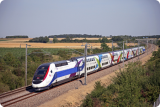
Report - High speed trains
The Center for Strategic Analysis has published a report: High-speed trains.
The TGV is one of our great technological achievements. While high speed rail was invented by the Japanese, the many records set by Alstom, in partnership with the SNCF and RFF, have regularly confirmél'excellence French technology: the last record, which dates from April 2007, established 574.8 km / h.
The TGV commuting for over thirty years, a significant number of passengers - more than 108 million passengers over the whole of 2010 - recognized in conditions of comfort, reliability and security. The main French cities are already served. Other cities soon will be, thanks to the 2000 kilometers of additional statutory programming on the implementation of the Grenelle Environment Forum.
The high speed is only about 10% of the total market of the French rail industry. It is nonetheless a strategic market, because of its symbolic character, reputation technology that gives the company Master's and the country develops, because finally the industrial ecosystem created around this area.
However, the global changes. The opening to competition of the rail system, the emergence of new manufacturers and technology development in China have dramatically changed the situation in the space of a decade. France is now faced in a competition increasingly fierce.
China has become the past two years, as the country leader in the development of high speed . In 2020, she planned on its territory a network of 16,000 kilometers of lines: on that date, all cities of more than 500 000 inhabitants should be served, and 90% of the population should be linked to future meshing. While high speed rail know some questioning in China, even before the accident in July 2011, its rapid development encourages us to continue our innovation efforts. France can remain at the forefront in this market but it will require adaptations and technological innovations.
This report presents a number of proposals designed to allow French companies to retain an important role in the development of high speed rail in the world, both in terms of its realization that its operation.
The success of the French high speed rail is the result of close cooperation between the state, the SNCF and the companies that have designed, with Alstom leader. This is the cohesion of all stakeholders in the sector which has in the past to export our technology in South Korea: it is now more essential than ever if we are to win new export contracts. In this as in many others, a contract can be won if the provider is responsive to his client and able to propose suitable products at reasonable prices. This necessary balance between supply needs can lead to a group response of all French companies or, alternatively, in separate initiatives, in accordance with the rules of competition - provided of course that these initiatives do not lead to about discrepancies between the French players in the industry.
As the report points out, creating a train of the future as part of "investments for the future," the sustainability of the domestic market of rolling stock (including through the "smoothing" commands) and an intelligent coordination of French actors export are three conditions necessary for the continuation of the industrial adventure of the French high speed rail, on our territory and the world. They are within our reach.
Mission chaired by Jean-Noel Chapulut and Jean-Didier Blanchet
Rapporteurs : Christine Raynard, François Vielliard Coordinator: Dominique Auverlot
Press contact:
Jean-Michel Roullé, Head of Communications
Tel.: +33 (0) 1 42 75 61 37 - jean-michel.roulle@strategie.gouv.fr

